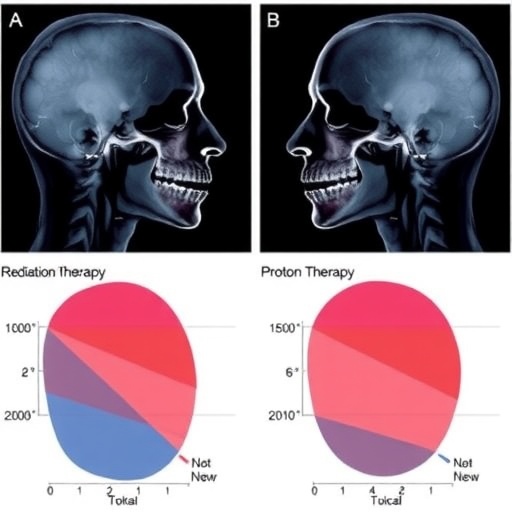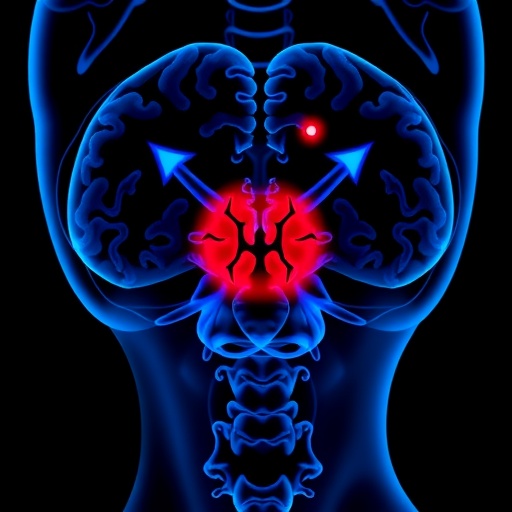In a groundbreaking phase III clinical trial known as TORPEdO, researchers have revealed compelling new evidence comparing two advanced radiation therapies—intensity-modulated radiation therapy (IMRT) and proton beam therapy—in the treatment of locally advanced oropharyngeal squamous cell carcinoma (OPSCC). This study, conducted extensively across numerous centers in the United Kingdom, underscores the therapeutic parity between these modalities in terms of patient quality of life, side effect profiles, and tumor control at the one-year mark post-treatment. The trial’s findings were unveiled at the 2025 American Society for Radiation Oncology (ASTRO) Annual Meeting, marking a pivotal moment in radiation oncology approaches for head and neck cancers.
OPSCC, a malignancy originating in the middle part of the throat, has been increasing in incidence globally, largely driven by the spread of human papillomavirus (HPV). This cancer predominantly affects men but represents the second most common HPV-related cancer in women. Standard intervention for this disease stage couples IMRT with concurrent chemotherapy, proven effective in tumor control but often accompanied by debilitating side effects such as severe dysphagia. These adverse reactions can necessitate feeding tube placement, profoundly affecting patient quality of life.
IMRT is a photon-based radiation delivery technique that employs precise modulation of the intensity of beams, sculpting radiation doses conformally to tumor geometry. While highly effective in eradicating tumor cells, this approach inadvertently exposes surrounding healthy tissues to low doses of scattered radiation, sometimes precipitating unwanted toxicities. Proton beam therapy, by contrast, uses charged particles with distinct dosimetric properties, enabling high radiation deposition at the tumor site with rapid dose falloff beyond the target. This theoretically allows greater sparing of normal tissues and a potentially improved side effect profile, but it requires highly specialized equipment and remains significantly more costly and less accessible.
The TORPEdO trial enrolled 205 patients with locally advanced OPSCC between 2020 and 2023, assigning them in a 2:1 ratio to receive either intensity-modulated proton therapy (IMPT) or IMRT, both administered alongside cisplatin chemotherapy. Demographically, the study population skewed predominantly male, with a median age of approximately 57 years and relatively low tobacco exposure, reflecting typical contemporary HPV-driven OPSCC patient profiles. The rigorously designed trial integrated both clinical and patient-reported outcomes as co-primary endpoints, focusing on feeding tube dependency, critical weight loss, and subjective assessments of side effects and quality of life via validated questionnaires.
After one year post-treatment, results strikingly demonstrated comparable and remarkably low feeding tube dependence in both treatment arms, with only 1.7% of patients in each group requiring ongoing nutritional support via gastrostomy. Interestingly, severe weight loss was more frequently observed in the proton therapy cohort (18.2%) as opposed to the IMRT arm (5.7%), though the aggregate composite clinical endpoint encompassing weight loss and feeding tube usage did not reveal statistically significant differences (p=0.08). These clinical findings run counter to expectations generated by prior preliminary research and prevailing hypotheses favoring proton therapy’s physical advantages.
Complementing clinical metrics were patient-reported outcome measures, which constitute a critical dimension in assessing cancer treatment’s holistic impact. No significant differences emerged on composite functional scales including saliva production, taste, chewing, swallowing, speech, and appearance, with scores nearly identical between the two modalities. Similarly, swallowing function assessments using the MD Anderson Dysphagia Inventory revealed virtually overlapping results, dispelling assumptions that proton therapy’s superior physical dose distribution translates straightforwardly into enhanced patient-perceived functional outcomes.
The TORPEdO trial’s rigorous quality assurance protocols fortified the validity of these findings, ensuring high fidelity in treatment planning and delivery across both arms. Conducted under the strict oversight of the UK’s National Radiotherapy Trials Quality Assurance Group, the trial guarantees that each patient received state-of-the-art care adhering to exacting standards, thereby isolating the modality choice as the variable of interest. This methodological robustness bolsters confidence in concluding that high-quality IMRT remains an excellent therapeutic standard for advanced OPSCC.
Furthermore, long-term oncologic outcomes echoed this trend of equivalence. With a median follow-up exceeding two years, both treatment arms exhibited outstanding local control rates nearing 95% and similar overall survival metrics, affirming that neither modality compromises efficacy. Proton therapy’s capacity to reduce radiation dose to adjacent critical structures, while demonstrable dosimetrically, did not translate into measurable differences in chronic toxicity or quality-of-life enhancements within this population and timeframe.
This body of evidence aligns with and adds nuance to previous studies that suggested proton therapy could reduce feeding tube dependency during the immediate post-treatment period, highlighting the importance of longitudinal assessment of patient outcomes. The absence of significant late outcome disparities suggests that reductions in radiation dose alone, though necessary, may not be sufficient criteria for widespread adoption of proton therapy in this clinical context, especially given its resource-intensive nature.
In sum, the TORPEdO trial represents a landmark inquiry providing robust, high-level evidence that modern, meticulously delivered IMRT achieves excellent disease control and maintains patient quality of life on par with proton therapy for locally advanced OPSCC. These insights advocate for the continued utilization of IMRT, a more accessible and cost-effective modality, while underscoring the imperative to explore novel strategies that could further minimize toxicity and enhance survivorship beyond radiation delivery technique alone.
The implications of TORPEdO resonate broadly within the radiation oncology community, informing clinical practice, health economics, and patient counseling. As proton therapy facilities remain limited and expensive globally, these findings will influence policy and reimbursement discussions, reinforcing the principle that advanced technology must demonstrably improve meaningful patient outcomes to justify widespread implementation. Future research directions may include investigational combinations of radiation with emerging systemic therapies, personalized adaptive treatment approaches, and integration of biomarkers predicting toxicity risk.
Significantly, TORPEdO’s focus on patient-reported outcomes as co-primary endpoints epitomizes the evolution of cancer trials towards embedding patient perspectives at the heart of clinical decision-making. By demonstrating that therapy choices leading to equivalent survival also yield comparable patient experiences, the trial empowers patients and clinicians to make informed decisions balancing efficacy, quality of life, logistical considerations, and healthcare resources. This paradigm shift heralds a new era in head and neck cancer management, where technological innovation must be married with rigorous evidence and patient-centered care.
The advanced dosimetry of proton therapy delivers lower radiation doses to adjacent swallowing muscles and salivary glands, a theoretically advantageous profile. However, the lack of corresponding functional improvement after one year highlights the complex, multifactorial nature of radiation-induced toxicity, which likely involves biological and rehabilitative factors beyond radiation dose metrics alone. This insight stimulates a reevaluation of how dosimetric data are interpreted and leveraged in clinical practice and trial design for head and neck oncology.
Dr. David Thomson, principal investigator of the TORPEdO trial and consultant clinical oncologist at The Christie NHS Foundation Trust, emphasized that while proton therapy continues to hold promise, high-caliber IMRT remains not only an effective but also a highly patient-friendly treatment modality. This highlights the critical importance of delivering advanced radiation therapy within quality-controlled frameworks, ensuring optimal outcomes regardless of technology used. Ultimately, patient-centered outcomes and accessible state-of-the-art care remain the cornerstones of progress against OPSCC.
Collectively, the TORPEdO findings represent a milestone, reframing expectations and guiding future radiation oncology strategies. They affirm that technological sophistication must be measured against tangible benefits in real-world, long-term patient experiences. These results will resonate globally, informing standards of care for thousands of patients navigating the challenges of oropharyngeal cancer treatment each year.
Subject of Research:
Oropharyngeal squamous cell carcinoma treatment using advanced radiation therapy modalities
Article Title:
TORPEdO Trial Reveals Comparable Long-Term Outcomes for Proton Therapy and IMRT in Advanced Oropharyngeal Cancer
News Publication Date:
September 29, 2025
Web References:
American Society for Radiation Oncology (ASTRO) Annual Meeting: http://www.astro.org/annualmeeting
TORPEdO trial abstract and session details: https://amportal.astro.org/sessions/pl-01-21644/primary-results-for-the-phase-iii-trial-of-toxicity-reduction-using-proton-beam-therapy-for-o-109477
Related phase III study on proton therapy and IMRT comparison: https://ascopubs.org/doi/10.1200/JCO.2024.42.16_suppl.6006
References:
TORPEdO trial data and presentation, David Thomson, MD, The Christie NHS Foundation Trust, ASTRO 2025 Annual Meeting
Keywords:
Oropharyngeal cancer, intensity-modulated radiation therapy, proton beam therapy, head and neck cancer, clinical trial, radiation toxicity, patient-reported outcomes, cancer survivorship, radiation oncology, HPV-related cancer
Tags: ASTRO Annual Meeting 2025dysphagia and cancer therapyfeeding tube complications in OPSCCHead and neck cancer treatment advancementsHPV-related cancersintensity-modulated radiation therapy comparisonpatient-reported outcomes oropharyngeal cancerPhase III clinical trial resultsproton therapy efficacyquality of life in cancer treatmentradiation oncology clinical findingsside effects of radiation therapy





